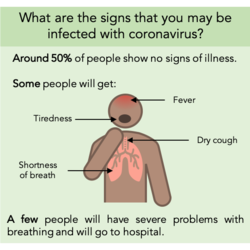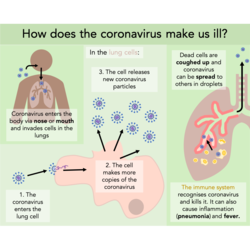By Ella Hopkins
This blog is one of three, explaining how the coronavirus makes us ill but at differing levels of complexity. This is very much inspired by the format of a brilliant YouTube series by WIRED, with their video explaining how CRISPR works being particularly well made.
I have spoken to many friends and family over the past weeks (whilst maintaining social distance, of course!) and have found a lack of understanding of how the coronavirus (SARS-CoV-2) actually makes us ill. Some have found that discussions about receptors and binding are too complex to understand, or quickly become uninteresting. (Others with a scientific background have found there isn’t enough information circulating on news sites that gets down to the nitty-gritty – if that’s you, skip to one of the next blogs for the detail.)
So here it is, in Plain English (for anyone who has forgotten all the science they learnt at school!)

Our bodies are made up of tiny living factories you can’t see with your eyes, called cells. Different types of cells do different jobs to keep us alive; one of their main roles is providing us with energy to keep us going.
The coronavirus, on the other hand, is not alive. It is just a bunch of complicated chemicals joined up together in the form of molecules called proteins and RNA.
The coronavirus can enter cells in the human body and uses the machinery in the cells to make more copies of itself. The new copies are released to spread to new cells and infect them too. This cycle leads to swelling and irritation in the airways that causes you to cough. Some lung cells may be killed and can lead to a shortness of breath.
Luckily, the human body has a special group of cells that fights off germs such as the coronavirus called the immune system. These immune cells can tell that the coronavirus shouldn’t be in our body and kill it. They can also kill cells with the virus in them, to stop it spreading further.
Our body can raise its temperature to help kill the virus too – this is why you often get a fever if you are infected with coronavirus.
In most cases, the immune cells are able to fight off the coronavirus and you become well again. You may become tired as the body fights off infection. However, some people with weaker immune systems, such as people with other diseases or old people, need help to fight it off. Hospitals can use respirators, a machine that helps you breathe, to make sure you get enough oxygen into your body when your lungs can’t do their job properly. There are also lots of medicines that are being tested at the moment that can help the body to fight off coronavirus better (more information on that in a later blog post!).
I hope you found this informative! If you would like any further explanation of any points, please comment after the blog and I will get back to you.
(To see that last graphic in more detail, use this link to a version on Twitter.)
